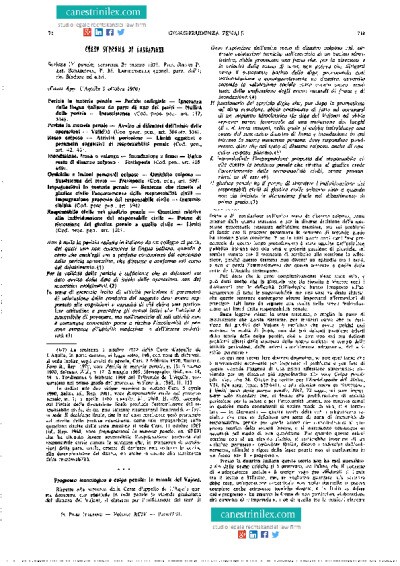
Date
Geographical Area
Europe
Countries
Italy
Keywords
Case Name
Biadene et al v Prosecutor
Case Reference
[1971] Sez. IV, 25 March 1971 (Cassazione Penale)
Name of Court
Supreme Court of Cassation, Rome, Italy (Corte Suprema di Cassazione, Roma, Italia)
Key Facts
In the evening of 9 October 1963, around 260 million cubic meters of rock broke off from the top of Mount Toc. It fell into the reservoir of the Vajont Dam, producing an enormous wave of at least 50 million cubic meters of water, which overtopped the dam in a wave of 250 metres. The dam, completed in 1959 and one of the biggest in the world at the time, did not suffer any serious damage. However, the resulting tsunami destroyed several villages in the valley and killed more than 2,000 people.
On 21 February 1968, eleven defendants were indicted by the pre-trial judge in Belluno for the crimes of culpable disaster aggravated by the predictability of the event, and multiple manslaughter.
On 17 December 1969, the L’Aquila Trial Chamber excluded the predictability of the landslide, convicting only three defendants as guilty of not having provided sufficient warning in time and therefore not commencing any evacuation measures.
On 3 October 1970, the L’Aquila Court of Appeal overturned the decision, confirming the predictability of the disaster. The Court of Appeal held that the managers of the dam were liable for their actions and omissions both before and after the transfer of responsibility for the dam from the privatised Adriatic Society of Electricity (SADE) to the National Agency for Electric Energy (ENEL). The responsibility of local and national authorities was also established, which later led to findings of liability in civil proceedings.
On 21 February 1968, eleven defendants were indicted by the pre-trial judge in Belluno for the crimes of culpable disaster aggravated by the predictability of the event, and multiple manslaughter.
On 17 December 1969, the L’Aquila Trial Chamber excluded the predictability of the landslide, convicting only three defendants as guilty of not having provided sufficient warning in time and therefore not commencing any evacuation measures.
On 3 October 1970, the L’Aquila Court of Appeal overturned the decision, confirming the predictability of the disaster. The Court of Appeal held that the managers of the dam were liable for their actions and omissions both before and after the transfer of responsibility for the dam from the privatised Adriatic Society of Electricity (SADE) to the National Agency for Electric Energy (ENEL). The responsibility of local and national authorities was also established, which later led to findings of liability in civil proceedings.
Decision and Reasoning
On 25 March 1971, the Supreme Court of Cassation confirmed that the Vajont Dam event was not a natural tragedy, but a disaster caused by negligence. Two defendants were convicted of culpable disaster and manslaughter, with one sentenced to 5-years imprisonment and the other to 3 years and 8 months. A 3-year amnesty was later given to both.
The Court highlighted the unique nature of the legal issues at stake, which required it to establish the contours of criminal liability for dangerous activities. In particular, the judges attempted to strike a balance between the social benefit deriving from such activities and the level of risk they involve. In doing so, the Court identified a number of principles that can be summarised as follows:
- The precautionary measures required when engaging in hazardous activities must be heightened and followed more strictly in the presence of significant risks;
- When natural or unknown forces are involved, the obligation to adopt adequate precautionary measures increases;
- Criminal responsibility for failure to prevent a disaster may only be excluded if the consequences of the event are unpredictable not only by the average individual but also by sectoral experts.
The Court highlighted the unique nature of the legal issues at stake, which required it to establish the contours of criminal liability for dangerous activities. In particular, the judges attempted to strike a balance between the social benefit deriving from such activities and the level of risk they involve. In doing so, the Court identified a number of principles that can be summarised as follows:
- The precautionary measures required when engaging in hazardous activities must be heightened and followed more strictly in the presence of significant risks;
- When natural or unknown forces are involved, the obligation to adopt adequate precautionary measures increases;
- Criminal responsibility for failure to prevent a disaster may only be excluded if the consequences of the event are unpredictable not only by the average individual but also by sectoral experts.
Outcome
The Vajont Dam event was not a natural tragedy, but a disaster caused by negligence.
Disclaimer
This case law summary was developed as part of the Disaster Law Database (DISLAW) project, and is not an official record of the case.
Document
Document